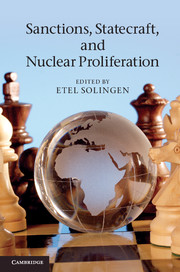Book contents
- Frontmatter
- Contents
- Figures
- Tables
- Contributors
- Preface and acknowledgments
- Part I Anatomy of inducements
- 1 Introduction
- 2 Sanctions, inducements, and market power
- 3 Empirical trends in sanctions and positive inducements in nonproliferation
- Part II Competing perspectives
- 5 An analytically eclectic approach to sanctions and nonproliferation
- 6 Threats for peace?
- Part III Reassessing the record: focused perspectives
- Part IV Conclusions: understanding causal mechanisms and policy implications
- References
- Index
- References
3 - Empirical trends in sanctions and positive inducements in nonproliferation
Published online by Cambridge University Press: 05 June 2012
- Frontmatter
- Contents
- Figures
- Tables
- Contributors
- Preface and acknowledgments
- Part I Anatomy of inducements
- 1 Introduction
- 2 Sanctions, inducements, and market power
- 3 Empirical trends in sanctions and positive inducements in nonproliferation
- Part II Competing perspectives
- 5 An analytically eclectic approach to sanctions and nonproliferation
- 6 Threats for peace?
- Part III Reassessing the record: focused perspectives
- Part IV Conclusions: understanding causal mechanisms and policy implications
- References
- Index
- References
Summary
Introduction
The end of the Cold War ushered in a new era of multilateralism that represented a fundamental change to the global balance of power. The exercise of statecraft to dissuade nuclear proliferation offers one example of this transformation, as countries and multilateral organizations utilized an increasingly diversified array of sanctions and positive inducements to address the issue. While past research has considered the flurry of sanctions activity in the post-Cold War environment – some declaring it a “sanctions era” – there is less in the literature that considers the general breadth of increased formal action, both positive and negative, exercised by international actors. From 1990 to 2009, four countries have been the primary targets of these coercive and persuasive tactics: Libya, Iraq, North Korea, and Iran. This chapter provides a trend analysis of sanctions and positive inducements implemented by individual countries and multilateral organizations to dissuade nuclear proliferators, and serves as an empirical foundation for subsequent chapters in this volume. Our analysis proceeds as follows.
We begin by offering working definitions of sanctions and positive inducements, highlighting the conceptual ambiguity that accompanies these terms. We then proceed to a general overview of empirical trends across our four cases, followed by individual country chronologies that parse out the actions related specifically to nuclear proliferation and their associated domestic ramifications. We conclude by providing a brief overview of notable cases beyond the four countries that constitute our primary focus here, highlighting the significant differences between the two groups. We also raise several issues that warrant further study.
- Type
- Chapter
- Information
- Sanctions, Statecraft, and Nuclear Proliferation , pp. 56 - 122Publisher: Cambridge University PressPrint publication year: 2012
References
- 6
- Cited by



